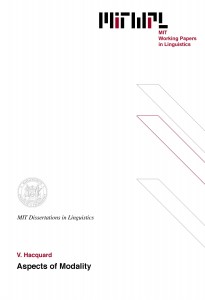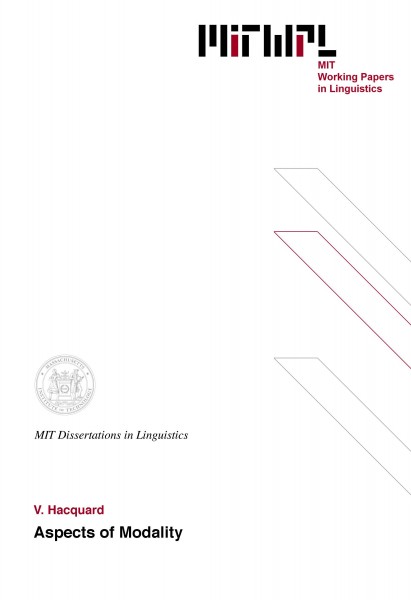Aspects of Modality
V. Hacquard, 2006
It is a cross-linguistically robust fact that the same modal auxiliaries come in different flavors: epistemic, deontic, ability, teleological... This fact is neatly captured in a system where each modal has a single lexical entry, where the difference in flavor comes from contextually provided accessibility relations (cf. Lewis 1973, Kratzer 1981). Equally robust, however, are the phenomena that suggest that epistemics and a subset of deontics are interpreted higher than the remaining flavors (subsumed under the label ‘root modals’). The goal of this dissertation is to show that a unified analysis of modal auxiliaries is maintainable, while still providing some principled explanation for the relative ordering of tense, aspect and the various modals in Cinque’s (1999) hierarchy, based on evidence in French and Italian.
To make sense of the relative scope of modals w.r.t. tense and aspect, I start with the empirical puzzle that aspect interacts differently with the various modal flavors. Perfective aspect on roots in French and Italian yields ‘actuality entailments’ (cf. Bhatt 1999), that is, an uncancelable inference that the proposition expressed by the complement holds in the actual world, and not merely in some possible world(s). I propose that this inference obtains when aspect scopes above the modal, and must therefore take the actual world as its world argument. Because epistemics/deontics are interpreted above aspect, they are immune to the effect.
To derive the height generalization, I propose to relativize the accessibility relation of a modal to an event, instead of a world: the accessibility relation has a free event variable, which needs to be bound locally, either by aspect (i.e., a quantifier over events), the speech event, or an embedding attitude verb. Further selectional restrictions on the event type each accessibility relation requires limits the possible combinations of event binders and accessibility relations. The resulting binding possibilities reduce the systematic constraints on the range of a modal’s interpretations to independently-motivated syntactic assumptions on locality and movement, and explain why the various flavors of the same modal auxiliaries are interpreted at different heights.
Thesis Supervisors: Kai von Fintel, Irene Heim
Title: Professors of Linguistics





